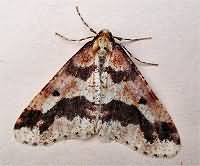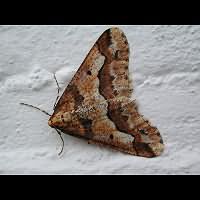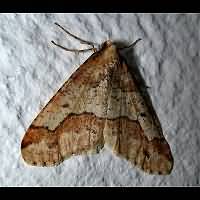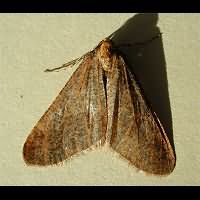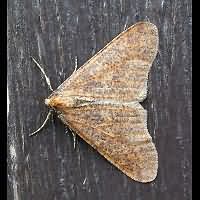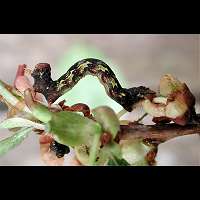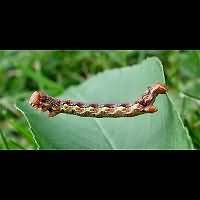Mottled Umber Moth (Erannis defoliaria)
The Mottled Umber Moth would have been the most awkward of all Geometers to identify, if it hadn't been flying in a period poor of moths: winter. Well marked animals may be identified with ease: two darkbrown bands running over the wing, often accented by very small black bands and a clear, black dot. Many of them are not that well marked, though. In some cases the bands are hardly visible and so is the dot, if present at all. Most difficult however are fully unmarked moths. They have a brownish ground colour with blackish spickles only. These do look like the Scarce Umber Moth a lot. The Scarce Umber however is goldenbrown, has a somewhat different wing shape and usually flies earlier. The Scarce Umber often shows some of its underwing, and that is something the Mottled Umber rarely ever does. The Mottled Umber has lighter and banded legs, while the legs of the Scarce Umber are unbanded and of the same colour of the wings. The Mottled Umber is not very variable in size: the wingspan runs from some 40 to 44 mm. Like in many other Geometers flying in winter all of this applies to the males only, for the females are wingless.
The eggs, which have been laid in winter, hatch in March. The caterpillar usually is active from then on till the end of May. The larva is variable too, but not as much as the adults are. The green caterpillar in the bottom picture probably is a recently moulded one which still has to grow its colours. For some reason the colouring of the caterpillars always reminds me of the adults. The caterpillar usually attaches a wire to the leaf it is currently sitting on. In case of danger it drops down and dangles at the end of its wire. When the coast is clear it climbs up its thread again. Fullgrown caterpillars use the thread to descent to the soil to pupate in a cocoon underground. This happens by the end of May or the beginning of June. Fullgrown larvae will be some 33 mm in length. The larvae feed on many wild trees and shrubs, including Hazel, Birch and Oak, but also on some cultivated species such as cherry and apple.
Even though most specimens are seen in October and November, the first animals may be on the wing in September, while the last ones may be seen as late as April. The Mottled Umber only flies by night, but is often found resting on trees, fences and walls during daytime. Happily comes to light, sometimes in very great numbers, giving you a good opportunity to study the many variations. In most of Europe one rule applies: wherever there are trees, there are Mottled Umbers. Common all over the British Isles and often abundant, especially in southern parts of England.
The Mottled Umber Moth would have been the most awkward of all Geometers to identify, if it hadn't been flying in a period poor of moths: winter. Well marked animals may be identified with ease: two darkbrown bands running over the wing, often accented by very small black bands and a clear, black dot. Many of them are not that well marked, though. In some cases the bands are hardly visible and so is the dot, if present at all. Most difficult however are fully unmarked moths. They have a brownish ground colour with blackish spickles only. These do look like the Scarce Umber Moth a lot. The Scarce Umber however is goldenbrown, has a somewhat different wing shape and usually flies earlier. The Scarce Umber often shows some of its underwing, and that is something the Mottled Umber rarely ever does. The Mottled Umber has lighter and banded legs, while the legs of the Scarce Umber are unbanded and of the same colour of the wings. The Mottled Umber is not very variable in size: the wingspan runs from some 40 to 44 mm. Like in many other Geometers flying in winter all of this applies to the males only, for the females are wingless.
The eggs, which have been laid in winter, hatch in March. The caterpillar usually is active from then on till the end of May. The larva is variable too, but not as much as the adults are. The green caterpillar in the bottom picture probably is a recently moulded one which still has to grow its colours. For some reason the colouring of the caterpillars always reminds me of the adults. The caterpillar usually attaches a wire to the leaf it is currently sitting on. In case of danger it drops down and dangles at the end of its wire. When the coast is clear it climbs up its thread again. Fullgrown caterpillars use the thread to descent to the soil to pupate in a cocoon underground. This happens by the end of May or the beginning of June. Fullgrown larvae will be some 33 mm in length. The larvae feed on many wild trees and shrubs, including Hazel, Birch and Oak, but also on some cultivated species such as cherry and apple.
Even though most specimens are seen in October and November, the first animals may be on the wing in September, while the last ones may be seen as late as April. The Mottled Umber only flies by night, but is often found resting on trees, fences and walls during daytime. Happily comes to light, sometimes in very great numbers, giving you a good opportunity to study the many variations. In most of Europe one rule applies: wherever there are trees, there are Mottled Umbers. Common all over the British Isles and often abundant, especially in southern parts of England.

